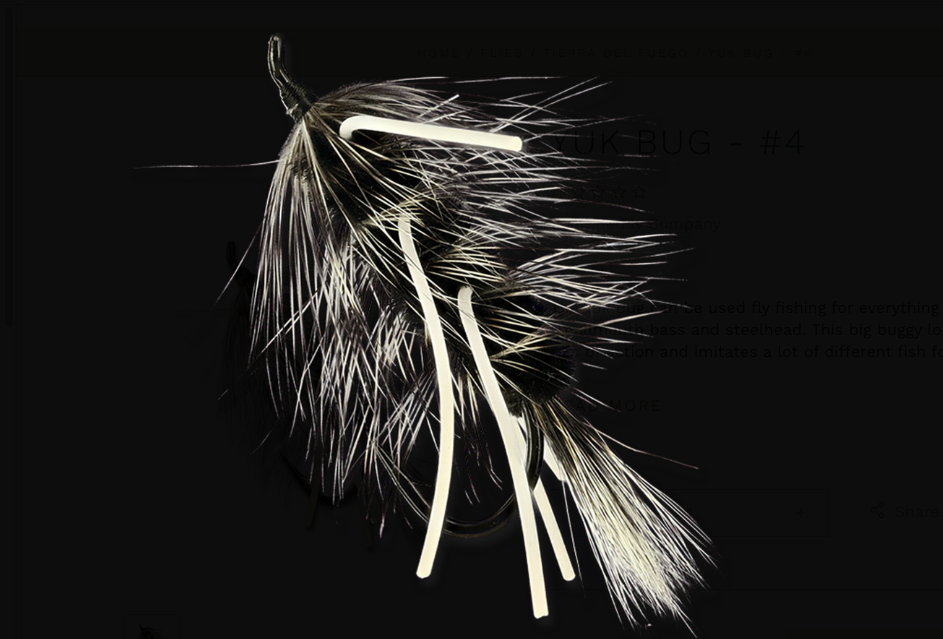
The southeast [Georgia, North Carolina, Virginia, West Virginia, and a small sliver of South Carolina] has some of the most productive trout [Oncorhynchus mykiss and Salmo trutta] streams and rivers in the Lower 48.
Streamer Strategies for Springtime Success
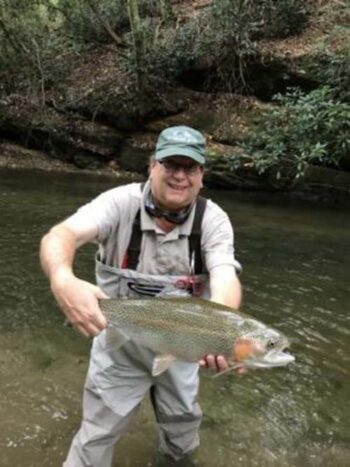
Steve is also a fine angler. Here, he’s ready to release a jumbo North Georgia rainbow. Hudson image.
By Steve Hudson
Now that spring’s here, everything is waking up in streams, rivers, lakes, and ponds far and wide. As water temperatures start to go up, fish begin chowing down – and in many cases, what they chow down on is minnows.
Fly fishers imitate minnows with streamers
‘These lovingly crafted minnow imitations range from very simple to remarkably complex, but all have one thing in common. To be effective, all must be fished in a way that makes ‘em look like real minnows.’
Here, in no particular order, are some things to consider when you fish streamers this spring. I’ll be keeping them in mind this very afternoon when I spend a couple of hours on one of my favorite warmwater streams in pursuit of springtime hybrids and early stripers, and next week I’ll recall them again on one of my favorite trout rivers. I’m betting they’ll pay off for me – and I’ll bet they’ll work for you too.
Do you know how to swim?
Mimic “minnow motion” – Presenting streamers is all about making your imitation look like the real thing, and (next to pattern) that comes down to motion. A buddy of mine once called it “minnow motion,” and if I can mimic it with my flies I’ll be off to a great start.
* To imitate a careless minnow that’s wandered away from the safety of cover, put the fly near (or even in) the cover and retrieve it in a relaxed manner.
* To imitate a panicked minnow (for example, one that’s suddenly realized it’s exposed and vulnerable in open water) cast close to cover and use a jerky, frantic retrieve.
* To imitate an injured minnow drifting along with the current (that is, a minnow that’s kicking only occasionally) allow the fly to drift freely with the flow but give it a tug every few seconds. You can even do this one casting straight upstream.
Remember that streamer fishing challenges you to work your fly so it imitates the behavior of an actual minnow. Do that, and you’ll be on your way.
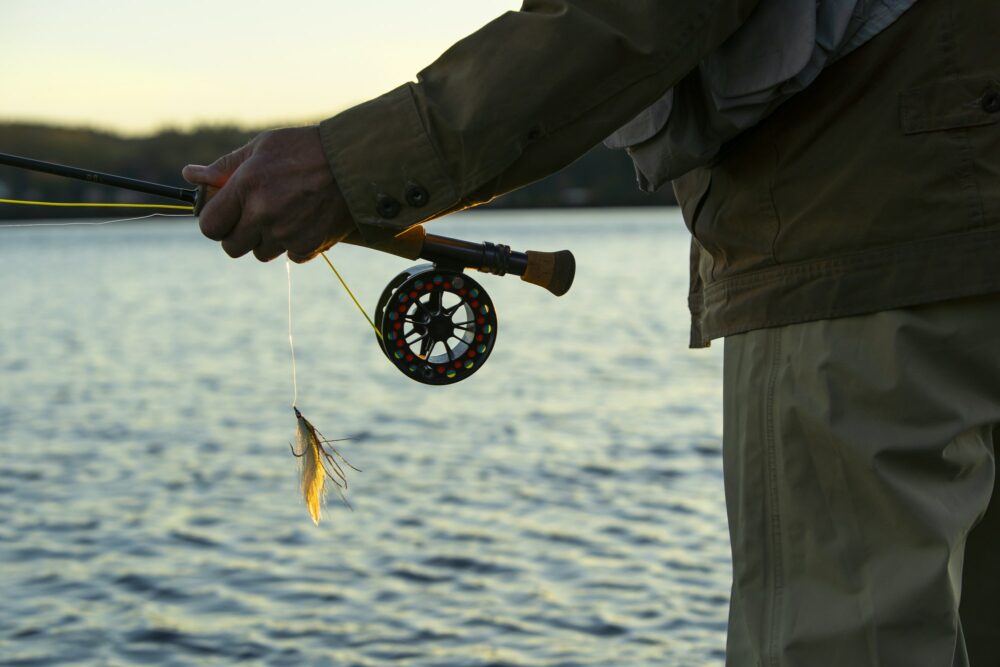
Giving ‘Lefty’s Deceiver’ a shot at a rising bow.
Keep stripping… – One mistake many streamer fishers make is to stop stripping far too soon. They’ll cast close to cover, strip a few times, then pick up and cast again. I can understand why they do this too. After all, it seems reasonable that “close to cover” is where the fish are. Right?
Sometimes that’s true, but there’s often more to it than that. Why? Because big fish (especially big trout, but other species too) can have commitment issues. They sometimes follow for a while before finally pulling the trigger. I once watched an enormous brown trout follow a big articulated streamer for perhaps 20 feet before it finally committed and struck at the fly.
So give ‘em all the time they need by stripping…and stripping…and then stripping some more…
…right up to the boat! – I admit it. More often than not, I don’t understand why fish do what they do, especially when they’re chasing dinner. If I was a hungry fish, I’d grab the meal the first chance I got. But fish do what fish do. So let the fish follow the streamer for as long as it wants, and remember that it may not grab it until the last possible instant. In other words, keep stripping…all the way back.
Vary your retrieve – One way to pique a reluctant fish’s interest is to try different retrieves. In other words, don’t stick with a single retrieve pattern if it doesn’t appear to be working on that particular day. For instance, if steady strips don’t do the job, try an erratic retrieve…or a fast one…or a slow one. Try everything! Let the fish see different kinds of motion. If the fish are in the mood to strike, sooner or later you will find a type of retrieve that they want to see.
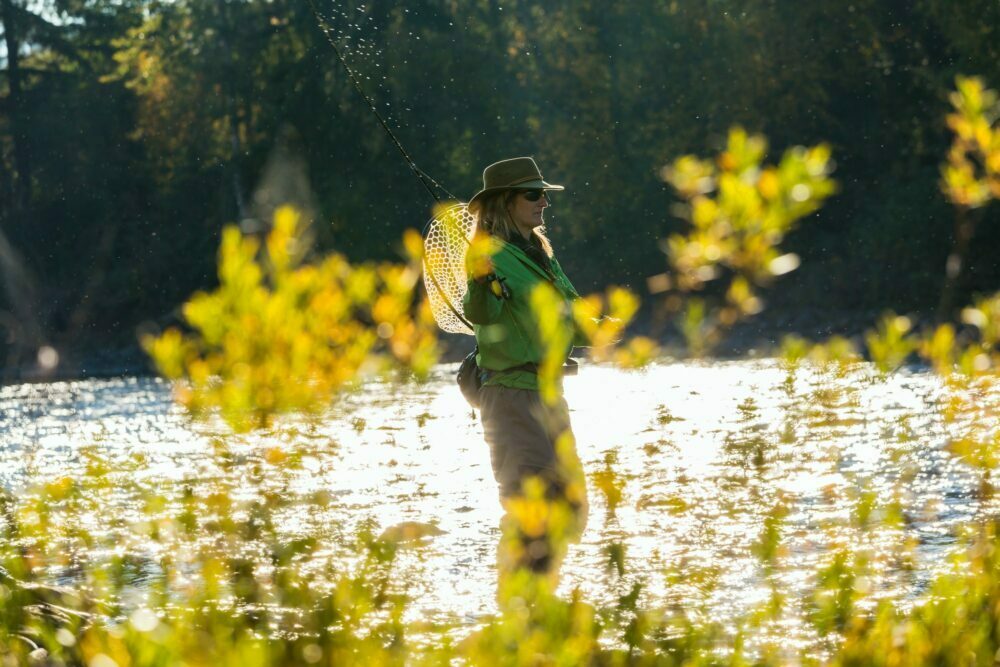
Rod at the ready and at one with the world; a pleasure.
If the water’s up, beat the banks:
In rivers and other flows, streamers can be effective when the water’s up, especially if you “beat the banks,” as they say.
Here’s why it works. When the flow picks up in a river or stream, baitfish take refuge in that narrow zone of relatively calm water right next to the bank. You can sometimes actually see them there by walking the edge of a river when the water’s up. Once in a while you’ll even experience the unforgettable thrill of seeing a big fish come roaring in to grab a quick snack. Now that’s a a sight to remember!
By the way, this kind of higher-water fishing is one exception to the “strip-to-the-boat” guideline mentioned earlier. Why? Because when the water’s high, baitfish tend to concentrate in that relatively calm near-the-bank zone. Once you pull your streamer out of that calm water, your fly will no longer be in the zone that the bigger fish are watching.
Embrace off-color water:
A lot of fly fishers hang up the rod when the water’s off-color. That may be reasonable if you’re using tiny dries. But when you’re throwing big, meaty streamers you just might want to stick with it.
Maybe this works because murky water provides cover for big fish, making them less cautious while they stalk their prey, or maybe it’s because they’re hunting using senses other than sight. I can’t say for sure. But I do know that it works, so don’t hesitate to keep casting even if the water gets a little dingy.
Swing the fly:
When fishing a streamer in moving water, most fly fishers like to cover a lot of water to give as many fish as possible a chance to see your fly.
One good way to do this is to “swing” the fly. First, cast toward the bank, angling your cast 30 to 45 degrees downstream. Immediately mend the line to eliminate slack. Then, holding your rod tip low, follow the flyline as the current carries your fly downstream.
The current will cause the fly to swim across the flow. To the fish, it looks like a minnow caught in the current and looking for cover. The predator fish may follow your fly for a while, so be patient. But it may also hit the instant it spots the fly.
At the end of the swing, don’t be in a hurry to cast again. Instead, let the fly hang momentarily below you in the current. When you do this, the fly will appear to be a minnow that’s holding in the flow, moving back and forth much like a real minnow would do. It’s surprising how many strikes you’ll get doing nothing but letting the fly hang there in the current.
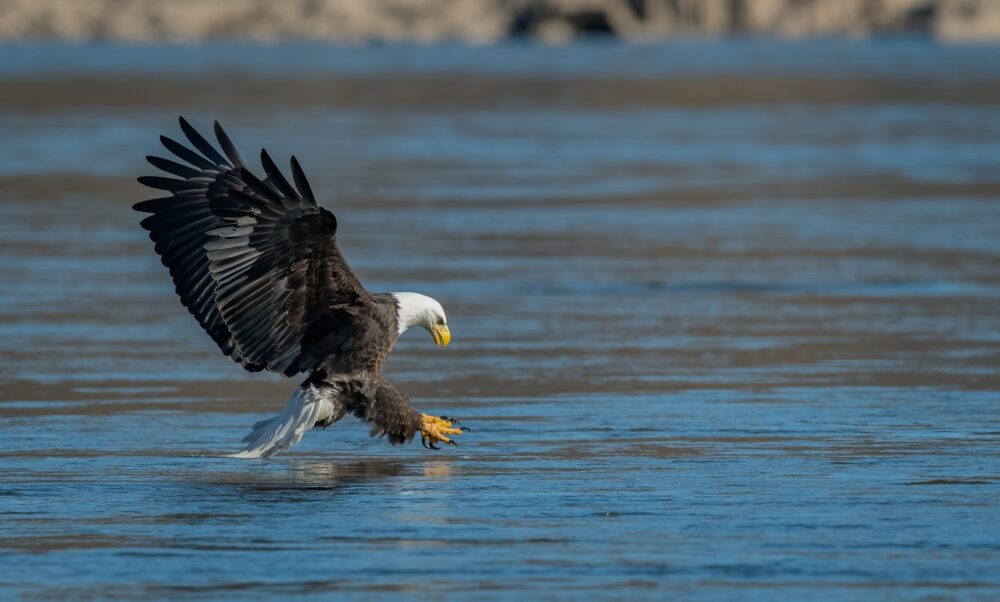
What’s this streamer thing anyway? Fishing ‘nature’s way instead.
Set the hook:
This one goes without saying. But you’ve got to do it right, and when you’re fishing streamers the right hook set is usually a “strip set.” Saltwater fly fishers do this as a matter of course, and it works fine in freshwater too.
Imagine you’re retrieving the streamer. You’re holding your rod tip with the tip held low (pointed toward the fish) and with your rod hand somewhat extended in front of you.
Strip…strip…strip…and there’s the strike!
At that instant, instead of lifting your rod tip, simply strip again – hard – while pulling your rod straight back and to the side. That drives the hook home. Then you can lift the rod and battle the fish .
Since strikes on streamers can come at any time, you want to be thinking “strip set” throughout the retrieve. Be ready, in other words. Remember to keep your arm extended (so your line hand has room to pull backwards during the hookset). And remember keep the rod low and not to lift the tip. Just pull straight back on the line instead.
I hope these considerations will give you something to think about this spring. No matter where you’re fishing, try throwing some streamers and then use these techniques to coax the fish into striking.
Then let the fun begin – and hold on!
About author, fly tyer, and angler Steve Hudson:
Steve is well known in the Southeast for his books on fly tying, hiking Appalachia, fly fishing, fly rod building, and creative writing professorship at local colleges. Click here to see his published works . . .


